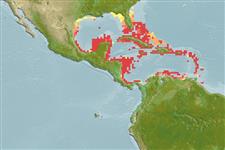>
Eupercaria/misc (Various families in series Eupercaria) >
Labridae (Wrasses) > Corinae
Etymology: Halichoeres: Greek, als, alis = salt + Greek, choiros = pig (Ref. 45335).
More on author: Poey.
Environment: milieu / climate zone / depth range / distribution range
Ecologia
marinhas associadas(os) a recifes; intervalo de profundidade 5 - 25 m (Ref. 9626). Tropical; 32°N - 9°N, 98°W - 59°W
Western Atlantic: southern Florida, USA and Bahamas to northern South America.
Tamanho / Peso / Idade
Maturity: Lm ? range ? - ? cm
Max length : 13.0 cm TL macho/indeterminado; (Ref. 7251)
Espinhos dorsais (total) : 9; Raios dorsais (total) : 11; Espinhos anais: 3; Raios anais : 12. The common color phase is white or yellow with two yellowish brown stripes, one along back next to base of dorsal fin and one on upper side which extends through eye to end of snout. Large adult males are blue-green to yellowish green on the upper half of body and pale blue on lower half; blue stripes on head; a large black spot at caudal base (Ref. 13442).
Inhabits coral reefs, normally high above the bottom. Swims with worm-like movements. Feeds on various invertebrates. A protogynous hermaphrodite (Ref. 55367). Generally of no interest to fisheries because of its small average size (Ref. 5217).
Ciclo de vida ou comportamento de acasalamento
Maturidade | Reprodução | Desova | Ovos | Fecundidade | Larvas
Diandric. Forms leks during breeding (Ref. 55367). Length at sex change = 7.9 cm TL (Ref. 55367).
Robins, C.R. and G.C. Ray, 1986. A field guide to Atlantic coast fishes of North America. Houghton Mifflin Company, Boston, U.S.A. 354 p. (Ref. 7251)
Status na Lista Vermelha da UICN (Ref. 130435: Version 2024-1)
Ameaça para os humanos
Harmless
Uso pelos humanos
Pescarias: espécies comerciais; Aquário: Espécies comerciais
Ferramentas
Relatórios especiais
Baixar XML
Fontes da internet
Estimates based on models
Preferred temperature (Ref.
123201): 26.3 - 28.2, mean 27.4 °C (based on 512 cells).
Índice de diversidade filogenética (Ref.
82804): PD
50 = 0.5000 [Uniqueness, from 0.5 = low to 2.0 = high].
Bayesian length-weight: a=0.00977 (0.00468 - 0.02039), b=3.09 (2.92 - 3.26), in cm total length, based on LWR estimates for this Genus-body shape (Ref.
93245).
Nível Trófico (Ref.
69278): 3.5 ±0.37 se; based on food items.
Resiliência (Ref.
120179): Elevada, tempo mínimo de duplicação da população menor que 15 meses (Preliminary K or Fecundity.).
Fishing Vulnerability (Ref.
59153): Low vulnerability (10 of 100).
Nutrients (Ref.
124155): Calcium = 97.5 [57.8, 166.9] mg/100g; Iron = 0.762 [0.440, 1.418] mg/100g; Protein = 18.5 [15.6, 20.7] %; Omega3 = 0.159 [0.101, 0.255] g/100g; Selenium = 22.1 [12.9, 40.7] μg/100g; VitaminA = 151 [47, 560] μg/100g; Zinc = 1.79 [1.22, 2.81] mg/100g (wet weight);
